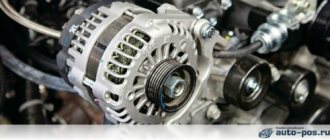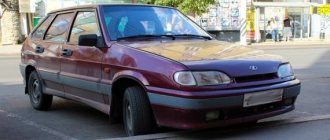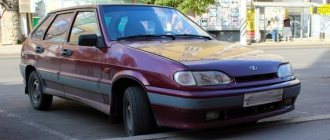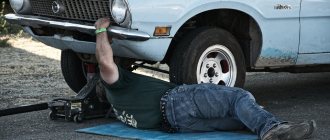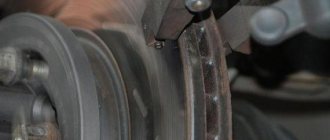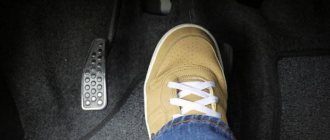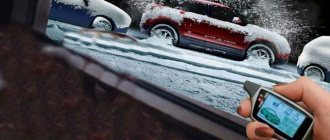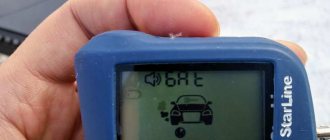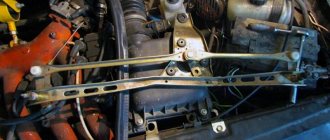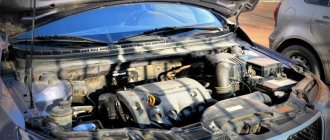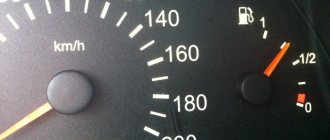The car brakes jerkily at low speed reasons
Secondly, the braking distance increases and becomes unpredictable (after all, you are already accustomed to certain parameters, and you may simply not calculate the distance when carrying out this process). In general, the conclusion from the situation suggests itself if it suddenly arises: it is not recommended to operate such a machine, and it is necessary to try to solve the problem as soon as possible.
Other possible causes of brake pedal beating
The cause of pedal beating may be uneven wear not only of discs or drums, but also of pads. During the braking process, the friction composition from which the clamping elements are made heats up to a very high temperature. Despite the fact that asbestos, which is very resistant to strong heat, is used as a reinforcing material, even it is unable to withstand significant temperature effects. When the pad pressure pad thins unevenly, the reverse hydraulic effect described above occurs, which causes the brake pedal to run out.
Read also: Absolute isopropyl alcohol GOST
Another reason for this effect is wear of the wheel bearing. This defect occurs quite rarely - probably only if the driver is careless and does not monitor the condition of the wheels. However, this cannot be excluded from the list of probable causes of brake pedal beating.
Sometimes the reason for the brake pedal beating is a simple looseness of the fasteners of the suspension components. True, the braking system has nothing to do with it - vibrations from loose bolts are transmitted first to the body, and then to the pedals. However, it looks like the brakes are faulty.
Gearbox and internal combustion engine
Having detected jerks when braking at speed, you need to make sure that the reason for this behavior of the car does not lie in the power plant. If the car is equipped with an automatic transmission, this will be easy to determine. Let the car coast without using the brakes and watch for jerking. If they are present, then there is a problem with the gearbox.
Problems can be caused by a faulty torque converter, valve body or control electronics, as well as an excessive fluid level in the box. You cannot operate a car with such defects, as the damage will begin to progress, aggravating the situation. Diagnostics and emergency intervention by a specialist are required.
What to do if the car shakes when braking
Sometimes cars shake when braking. And while vibration during braking is easy to fix, you must remember that any problem with a vehicle's braking system is a safety issue. Here's what you need to know and do if you notice your car shaking when you press the brake pedal.
Calipers and bearings
Worn-out calipers are a sad matter: there is only one option: replacement. The same can be said about wheel bearings: the most reliable option to eliminate their play is to purchase and install new elements. But it’s still worth checking them first.
Place the car on a jack, remove the wheel and rock the brake disc in different directions. If no play is detected, there is no need to calm down: inspect the bearing, make sure that it has lubricant. If there is even a slight suspicion of a defect, contact the nearest car service: replacing parts requires the use of special devices: pullers, etc., as well as experience.
Brake mechanism
New cars are often equipped with floating caliper brakes. The disadvantage of this type of braking mechanism is its increased sensitivity to contamination. It is the dirt that causes the piston in the cylinder or the guide pins to jam, as a result of which the car brakes jerkily when braking. This is fraught with serious trouble, and therefore it is strictly forbidden to go further.
It is better to call a tow truck, which will deliver the car to a service center to diagnose and determine the causes of the incident. It would be worth mentioning that jerking during braking can be caused by breakdowns of the hand brake drive, brake cylinder and drum mechanism. These problems cannot be ignored, as they can provoke an accident. Well, delays in visiting a service center are guaranteed to increase the final cost of repair work.
Automatic transmission diagnostic methods
Many years of practice have made it possible to develop a clear and effective method for diagnosing a car’s automatic transmission in case of any malfunctions, even when the automatic transmission is pushed. This technique is identical for cars of any brand that has it, regardless of the manufacturer, and involves a set of verification actions. These include a thorough check:
- signs of deviation from the norm;
- quality and level of liquid;
- engine operation in low, medium, high speed modes;
- pressure in its hydraulic system.
In addition, two tests are practiced: on a stopped car and while it is moving. When diagnosing, it is very important to clearly establish at what point in the functioning of the automatic transmission the interruptions begin. There can be several of them: when the car is just starting to move, or when it smoothly picks up speed, when it accelerates or brakes sharply, in which gear - low or high - this deviation from the norm is recorded, what engine crankshaft speed is low or high.
This comprehensive algorithm will allow you to eliminate the causes of automatic transmission failure step by step until the key reason why the machine constantly twitches becomes clear. This can happen, for example, when the internal combustion engine cushion is torn, when the chassis “acquires” play, the power unit cushion is worn out, the fluid level is excessive, dirt has accumulated inside the mechanism, etc.
Brake discs
If you had them installed recently, then one of the likely reasons for the car braking jerkily is unprofessional repairs. Discs are installed in strict accordance with the instructions for a specific car brand. Also pay attention to the condition of this spare part: if it is bent (perhaps you bought a defective one), you will have to contact the nearest service station. There your disc will be sharpened if its thickness allows this; otherwise you will have to buy a new one. Along the way, it is worth noting that the operation of brake discs (and drums) is associated with strong heating, up to 100 degrees. If at this moment the wheel gets into a puddle, the probability of curvature occurring is very high (in 90% of cases, jerks during braking are associated precisely with the curvature of the discs). You can check this part for bending yourself:
- To do this, you need to jack up the car on both sides along one axis: both rear wheels or two front wheels.
- Next, you will need an assistant: you spin the wheels one by one with your hand, and he smoothly squeezes the brake pedal.
- The beat will be visible immediately. A small nuance: if you decide to change the brake disc, it is recommended to do this simultaneously on two pairs of wheels (left and right). If the car has been parked for a long time, corrosion of the disc is possible: then simply sand it with fine sandpaper or drive 500-1000 km.
Troubleshooting Methods
Now let's move on directly to the description of repair work that can be used to fix the problem when the car brakes jerkily at low and/or high speeds. We list the methods in the same order as the reasons. So:
- Airing the system . In this case, it is necessary to pump it, remove the air and add the required amount of new brake fluid. You will find the relevant information in the material, which describes how to properly bleed the brake system of a car.
- Warped brake disc . There are two possible options here. The first is that if the thickness of the disk is large enough, then you can try to grind it on a special machine. To do this, seek help from a service station or car service center. However, not all services perform such work. You can contact a familiar turner. The second option is more rational and safe. It consists of completely replacing the disk if its deformation is significant and/or the disk is already worn out and quite thin. In this case, it is better not to take risks and make an appropriate replacement. And you need to change discs (drums) in pairs (left and right at the same time). Checking the disk yourself only makes sense if the disk is severely damaged. Therefore, it is better to carry out inspections, and even more so repairs, at a specialized service station.
- Incorrect installation of disks . To correct the situation, you must remove and install the disk/disks exactly in accordance with the instructions.
- Drum curvature . There are two ways out here. The first is to give it to a turner for boring. The second is their replacement. Depends on the degree of wear and curved geometry of the drums. But it is better to install new nodes.
- Worn pads . In this case, everything is very simple - you need to replace them with new ones. The main thing is to choose them correctly. And the replacement procedure can be performed independently (if you have experience and understanding of such work) or in a car service center.
- Pad sticking . It is necessary to carry out repair work on the lift to restore the functionality of the pads and calipers. It is best to replace the used pads with new, good quality ones to prevent similar situations from occurring in the future.
- The calipers are loose . Repair in this case is impossible. It is necessary to replace the calipers, pins, and, if necessary, pads. When reassembling all components, do not forget to lubricate everything thoroughly with caliper and guide grease.
- Inconsistency between the softness of discs and pads . When choosing these and other nodes, you need to pay attention to the corresponding stiffness value. If necessary, replace some or other parts.
- Large play in wheel bearings . Here, most likely, you will have to replace the corresponding components. You can try to repair them, however, as practice shows, such an idea is ineffective.
- Rust on the brake disc . If the rust deposit is small, then you can do nothing, but operate the car for 500.1000 kilometers until the rust is naturally removed under the influence of the brake pads. Another option is to groove the discs. In fact, the second option is preferable, but more expensive.
- Damaged silent blocks . It is necessary to inspect the mentioned components and, if necessary, replace them.
Causes of jerking when braking
First, let's list the most common reasons why a car brakes jerkily. So, these include:
- Airing the hydraulic brake system . This phenomenon occurs due to depressurization of the corresponding system on hoses, cylinders or in its other components. Air in the brake system reduces the efficiency of its operation, including sometimes a situation when the car brakes jerkily when braking. Often, before the appearance of jerks, there is a general decrease in the effectiveness of the braking system. Therefore, jerking is the final signal that the system needs to be pumped and brake fluid added to it.
- Curvature of brake/brake discs . This situation may arise, for example, due to their sudden cooling. In particular, after sharp braking, when the disc is very hot, the car drives into a puddle of cold water, as a result of which a sharp temperature difference occurs in the material from which the brake disc is made. If it (the material) is not of sufficient quality, then there is a possibility that the product may change its geometric shape (it may become trite). This situation is especially relevant for non-original or simply cheap low-quality discs.
Types of brake disc deformation
Remember that the thickness of the brake discs must be more than 20 mm! If this is not the case, both disks must be replaced.
There is a special device - a dial indicator, with which you can measure the degree of runout of the disc on the pad. It is available at most service stations, as well as for free sale, and is inexpensive.
- Rust on the disc . A very exotic option, relevant, in particular, for used cars from Japan. So, when the car is parked for a long time without moving, a coating of rust forms between the brake pad and the disc, which is subsequently perceived as impacts during braking. The phenomenon is especially active when the disks rotate synchronously. For reference: in the coastal conditions of Japan or Vladivostok (fog, high humidity), the discs can rust in just a couple of months, provided that the car is parked outside without moving.
- Incorrect disk installation . When replacing this unit/assemblies by inexperienced craftsmen, situations sometimes arise when the disc is installed crookedly, which causes friction against the pad. This is even if the disc is new and smooth.
- Drum curvature . Similar to the previous points. Changes in drum geometry can be caused by wear or due to sudden changes in their operating temperature.
- Worn brake pads . Some car owners note a situation where, with very worn brake pads, the car begins to brake jerkily. A whistle when braking can also confirm wear. It can be caused either by a critical level of pad wear or by the work of the so-called “squeakers” - special metal antennae that rub against the discs, causing a squeak and thereby signaling the car owner about the need to replace the brake pads. Sometimes vibration is possible when operating even new pads, often provided that they are of very poor quality.
- Rear pads sticking . This is a fairly rare situation, which sometimes occurs in the case of prolonged braking and poor-quality pads. But in this case, vibration will occur not only during braking, but also while driving.
- The front calipers are loose . More precisely, we are talking about the fact that their fingers were simply worn down during use. This situation occurs infrequently and only on cars with very high mileage.
- Inconsistency between the softness of discs and pads . This situation implies that “soft” discs (drums) and “hard” pads were installed. As a result, the pads bite into the discs (drums), thereby damaging them. Worn brake disc
- Large play in wheel bearings . In this case, when braking, the wheels will vibrate, and this will automatically cause vibration of the entire car. This is especially true for the front wheels, as they are more heavily loaded during braking.
- Damaged silent blocks . We are talking about the silent blocks of the rear suspension. With significant wear and tear, some motorists note a situation where the car begins to jerk when braking.
According to statistics, about 90% of cases when vibration occurs when driving is associated with curvature of brake discs . Accordingly, the check must begin with these nodes.
Brakes may be the culprit behind car wobbling.
Perhaps the main cause of car shaking when braking, especially at highway speeds, is the brake system itself. Most cars today typically have disc brakes on the front. At the rear, in addition to disc brakes, drum brakes are also still often found (on cheap economy class cars).
Disc brakes are connected to the brake caliper where the brake pads are clamped. When you press the brake pedal, the brake caliper presses the pads against the brake rotor (much like how brakes work on a bicycle). As a result, the wheel begins to slow down, which stops the car. But, alas, nothing lasts forever in this world. It is logical that brake pads and brake discs wear out over time due to friction, temperature changes, etc.
This ultimately leads to uneven wear of the brake discs (the surface of the discs will become uneven). Our driving style also affects the wear of brake discs. For example, if you're a fan of jumping off at traffic lights and braking hard at red lights, you're not only causing your brake pads to wear out quickly, but you're also shortening the life of your brake rotors. Sharp and frequent braking on slopes is especially dangerous, as this causes deformation of the brake discs.
see also
10 noises in a car that can bother the driver
As a result, due to the unevenness of the discs when the brake pads contact when pressing the brake pedal, the vehicle may shake, which is mainly felt in the steering wheel.
There are usually two options: replace the brake discs, which will cost a pretty penny, or repair the discs by having them sharpened, if, of course, their remaining thickness allows this. But if it is possible to buy new brake discs, then it is preferable to do so. If you want to save money, it is easier to purchase non-original wheels. Ideally, of course, the brake discs should be replaced with each brake pad replacement. But, alas, not everyone can afford such a luxury.
What to do if the reason is ATF
Often the reason why a car experiences a shock or a jolt during braking is that the ATF level does not correspond to that recommended for normal operation of the unit. It turns out that if the working fluid has an excess or deficiency, this can provoke foaming. Then the automatic transmission pump fails to pump a sufficient volume of oil to the parts in contact one with the other. Constant oil deficiency leads to wear of some parts. Their forced contact “dry” ends in an unwanted jerk of the car, leading to strange jolts, and even sharp impacts when one of the gears is engaged. This is doubly undesirable for a car when it operates for a significant period of time in urban conditions, where there are constant changes in speed due to traffic jams, irregular traffic on roads with traffic lights, etc. In such conditions, problems with the automatic transmission progress literally before our eyes.
The following logical algorithm suggests itself: having detected the automatic transmission twitching when switching, the first step should be to check the fluid level. It should definitely be brought back to normal by adding the required amount or, if there is excess, draining the excess. Then check the fluid for cleanliness. If signs of contamination are found, replace it. It will also be necessary to change the filter, remove deposits from the filter mesh, etc. We must not forget that the box certainly requires that it be warmed up at a low temperature before starting to move.
Why does the machine twitch?
An emergency situation, when the car’s automatic transmission “kicked” and twitched unpleasantly, is familiar to many. In such cases, some drivers, without delving into the reasons for what was happening, turned for help to service centers or to familiar professional automotive mechanics, who began to troubleshoot problems, often completely rebuilding the box, thoroughly changing one of the main blocks or even several of them . This method of adjusting an automatic transmission, of course, also has a right to life, however, it would be much more logical if the driver himself thoroughly understood the reasons for what happened in order to understand in the future what is happening.
Often it’s not that difficult to figure out. In modern cars with an automatic transmission, kicking is often caused by turning on the “Drive” mode. This problem can often be resolved by simply changing the oil in the transmission, after which the unwanted shocks will completely disappear. However, this does not always happen; sometimes even after a complete change of oil and filter element, no positive changes will occur, the shocks remain. Then the car owner will have to resort to full diagnostics in order to accurately find out the real cause and then eliminate it.
Further actions
But if you were unable to eliminate the causes of this phenomenon in fairly simple ways, then the matter is much more serious. Check the condition of the silent blocks and steering tip.
You can do this yourself, but it’s best to go to a service station and have the vehicle diagnose it (this shouldn’t take much time or money), and if necessary, change it. In addition, there you can thoroughly check the wheels for signs of curvature. Maybe this is the reason?
Perhaps the cause of this flaw is the brake discs. It happens that after intense braking they drive into a puddle, for example. And, as an option, a trip to the car wash with “hot” brakes. And then the disks can “lead” from a sharp change in temperature. Especially if they are not original (although it’s easy to spoil factory ones in this way if the process is sufficiently regular).
Check the discs at a service station, on a lift, for their integrity and evenness (both front and rear can be damaged). If they are crooked or oval, then they need to be sharpened.
This procedure is carried out with the help of a qualified turner, which is not available at every car service center. Therefore, if the wheels are bent, first ask your friends, those who have done a similar execution with their car. Make an initial agreement with a turner (preferably a recommended one), because the turning process itself takes some time and requires significant material costs from the machine owner. Yes, and remember that they can only be sharpened to certain parameters.
If they are too thin due to wear, then most likely they need to be replaced, which will require additional investments, but the problem - why the car brakes jerkily when braking - should be radically resolved.
When the box has nothing to do with it
It should be noted that the reason why a car suddenly starts to twitch strangely when starting to move, braking or accelerating for no reason at all is not always the automatic transmission. There are cases when this occurs due to the influence of low-quality fuel or interruptions in the ignition system. Since the car is one system unit, a malfunction in the operation of the engine or ignition automatically leads to deviations in the functioning of the automatic transmission. Then car diagnostics are also inevitable.
The driver should make it an ironclad rule to follow technical recommendations and preventive measures that will make it impossible or, in the extreme case, delay as long as possible a malfunction in the operation of the vehicle. This is, first of all, filling the engine with only the high-quality oil recommended by the manufacturer. In addition, strict adherence to the interval for replacing filters and fluid and, as already noted, warming up the automatic transmission when using the car at low temperatures are mandatory. Of course, you also need to operate your car carefully and from time to time have it undergo a full technical inspection, using the services of reputable service centers and good diagnosticians.
There are a number of reasons why a car brakes jerkily . Among them are the use of new, not yet ground-in brake pads, air getting into the braking system fluid, curvature of the brake discs, partial failure of silent blocks and/or steering ends, problems with the pendulum bushings. In isolated cases, a situation is possible when the car not only brakes jerkily, but also hits the steering wheel.
It’s worth saying right away that the listed malfunctions are very dangerous and can lead not only to the failure of critical components of the car, but also to the creation of an emergency situation on the roads! Accordingly, if a situation arises when the car brakes jerkily, it is necessary to take emergency measures to identify the malfunction and eliminate it.
Additional pumping
So, you have checked the system - no fluid is leaking. Its level is also normal (does not go away). In addition, the brake pads were recently changed. So there shouldn't be any problems with this. But, perhaps, when replacing the pads, air got into the system, and you did not bleed the system enough. Try again: maybe the problem can be solved in such a simple way?
For this you will need an assistant. And then - according to the scheme: the first one presses the pedal, the second one releases the hose and, releasing air, plugs the hose. Then the sequence of operations is repeated until the liquid flows. Then we finally put the hose in place. Don't forget to add fluid to the reservoir!
It also happens that after several tens of kilometers traveled, the new pads grind in and seem to “find” their place. And the jerky braking disappears. In such cases, be patient and wait until it disappears. If this does not happen, we continue to analyze.
{banner_content}
Substandard or worn brake pads
Such pads have a variable coefficient of friction. As a result, the friction lining either works decently, then burns or melts - and then the friction coefficient drops. The alternation of such processes leads to jerks. Well, if the pads are worn down to metal, then jerking begins when the cast-iron disc is scuffed by the steel base of the pad. The pads should be replaced immediately, and if the discs are damaged, they will have to be sharpened or replaced.
The brake pads may look normal, but if jerking occurs after they are installed, action must be taken. Brake pads may look normal, but if jerking occurs after they are installed, action must be taken.
Wheel bearing play
If there is a large gap in the bearing on which the wheel rotates, then the brake disc (drum) will dangle unpredictably relative to the brake pads. The contact between the pads and discs will be uneven and oscillating, which will lead to jerking during braking. Driving with a loose bearing is very dangerous. Urgently for repairs.
You cannot simply tighten a very loose hub assembly - the wheel bearing must be replaced.
You cannot simply tighten a very loose hub assembly - the wheel bearing must be replaced.
What can happen if the car brakes jerkily when braking?
If the movement occurs on a slippery surface, the car may skew to one side: as a result, the car moves out of its lane. You will still be “lucky” if, after skidding, the car ends up on the side of the road or crashes into a snowdrift. It will be much worse if the vehicle drifts into the oncoming lane.
What else is fraught with the situation when the car brakes jerkily? This is an increase in braking distance and an unpredictable change in the trajectory of movement when braking. All this can lead to a collision. Below are the main elements of the car that cause jerking when braking.
Sticky and hard pedal
The reasons for this phenomenon are clearly indicated: malfunctions of the vacuum booster, brake cylinders (main and/or wheel) and brake hoses.
What exactly? This could be dirt in the brake circuits or excessive external contamination of the calipers. A car service specialist will give an accurate verdict.
And there are even anecdotal cases with hoses. For example, “crooked” installation during repairs. Screw in the fitting and twist the hose repeatedly. Or they install a hose of the wrong length, and it behaves unpredictably - at first everything is fine, and then it is pinched by some kind of rod during a sharp turn.
In a word, hard pedal - for service, for service...
Causes of car steering wheel vibration
The main mistake that the vast majority of car owners make is that they begin to look for and eliminate the causes of steering wheel beating in a descending manner. According to the degree of monetary and time costs. In this order, we will consider the causes of vibrations in the steering wheel:
- imbalance and damage to wheels (tires and rims);
- uneven wear of the front brake pads (although unevenly worn rear pads can also cause steering beating);
- a worn steering rack with play and increased gaps;
- wear and play in the tie rod ends;
- worn lower (and sometimes upper) ball joints of the suspension;
- worn-out silent blocks of stabilizer struts, reaction rods, as well as rods and mechanisms for maintaining lateral stability of the car;
- damaged and sometimes even bent wheel drives in a front-wheel drive car and/or a damaged bent driveshaft in a rear- or all-wheel drive car.
At the very beginning, drivers' suspicions fall on unbalanced wheels, and their first visit is to a tire service, although logically they should begin their research in order of decreasing danger. That is, from the steering control. However, by and large, this path is not entirely correct.
The correct solution is this: first of all, you need to find out the location and cause of the vibrations. Full diagnostics (including saving money and time) can be carried out exclusively at a car service center. However, this may be indicated by indirect signs and symptoms.
Steering wheel wobble at speed
When a driver tells a car mechanic (or his more experienced motorist colleague) that the steering wheel in his car shakes at speed, he will always hear many more related and clarifying questions: ... and when braking? ...and in a turn? ...and when maneuvering?
Runout in the steering wheel can occur for a variety of reasons, from unbalanced wheels, damaged disks or tires to a violation of the geometry of the front suspension (see the list of potential faults two paragraphs above). And in this case, an unambiguous complete diagnosis of the vehicle’s chassis (including the transmission) is required on a special vibration stand or on a stand with running drums (by the way, at a self-respecting car service center, all this is done on one stand and within a few minutes).
Tires could be to blame
One possible cause of your car shaking when you press the brake pedal, especially at high speeds on the highway or when going downhill, is your vehicle's tires. This is the first thing you should investigate if you feel your car shaking while braking. Moreover, we are not talking about wheel alignment (wheel alignment). For example, if the wheel alignment is correct, when the wheel balancing is off, your car may shake not only when braking, but also when driving at a speed of more than 90 km/h.
So don’t forget about wheel balancing and periodically stop by a tire shop to check it.
Especially if you recently flew into a deep hole in the road. The fact is that from time to time wheel balancing can go wrong. For example, if you hit a bump, the balancing weight attached to the wheel may fly off. As a result, the rotation of this wheel may be uncentered, which will lead to the steering wheel wobbling at speed, as well as the car shaking on the road when braking. see also
Why is the car shaking?
A tire mechanic can easily and quickly check wheel balancing and fix the problem. A similar problem can also occur when the tire is damaged or worn out. In this case, you will have to buy a new tire.
